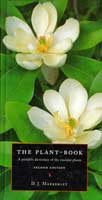
The plant book, 2nd edition
By D.J. Mabberley
ISBN 0521414210, published in 1997 by Cambridge University Press, hard cover, 858 pages
Price $A99.00 plus $A10 postage within Australia or $A30 overseas airmail
WEED INFORMATION
|
|||||
| Services | What's new | Home | |||
 |
The plant book, 2nd editionBy D.J. Mabberley ISBN 0521414210, published in 1997 by Cambridge University Press, hard cover, 858 pages Price $A99.00 plus $A10 postage within Australia or $A30 overseas airmail |
A portable dictionary of the vascular plants. The plant-book is internationally accepted as an essential reference text for anyone studying, growing or writing about plants. In over 20,000 entries this comprehensive dictionary provides information on every family and genus of seed-bearing plant (including gymnosperms) plus ferns and other pteridophytes, combining taxonomic details with invaluable information on English names and uses. In this new edition each entry has been updated to take into consideration the most recent literature and almost 2500 new entries have been added, ensuring that The plant-book continues to rank among the most practical and authoritative botanical texts available.
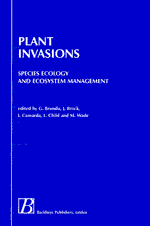 |
Plant invasions: species ecology and ecosystem managementEdited by G. Brundu, J. Brock, I. Camarda, L. Child and M. Wade ISBN 9057820803, published in 2001 by Backhuys Publishers, The Netherlands, soft cover, 338 pages Price approx. $A220.00 (may vary with exchange rate) plus $A10 postage within Australia or $A30 overseas airmail |
Plant invasions are a major issue in ecological science. They impact on ecosystems around the world, often with disastrous results to the inhabitants of those ecosystems. The mass transport of goods and people, as well as the degradation and fragmentation of natural habitats through rapidly increasing human populations and urbanization, and intensive agricultural and forestry practices, are major driving forces that increase the movement of species over natural boundaries and influence the success of new invasions. As a result, the flora of most countries is rich in non-native plant species. Not all alien species cause problems, however become aggressively invasive in their introduced range and can cause significant impact.
This book builds on material presented at the 5th International Conference on the Ecology of Invasive Alien Plants, 13–16 October 1999, held on the Mediterranean island of La Maddalena, Sardinia, Italy. Key papers from the more than 100 contributions (papers and posters) received from 20 countries across five continents are presented here.
The book commences by addressing the general questions on invasion biology, i.e. what are the crucial issues that favour invasions and how can the impacts of these invasions be predicted. The bulk of the book contains case studies on the ecology of single invasive plant species. These include Mimosa quadrivalvis in Malaysia, Mimosa pigra in Sri Lanka, Robinia pseudoacacia, Amorpha fruticosa and Papaver spp. in Italy, Solidago gigantea in Hungary, Mycelis muralis and Gunnera tinctoria in Ireland, Gleditsia triacanthos in Agrentina, Paspalum vaginatum in Sardinia, Rudbeckia laciniata and Bidens frondosa in the Czech Republic, Acer negundo in Poland, Oenothera spp. in USA and the Czech Republic, Carpobrotus spp. on Mediterranean islands, Impatiens glandulifera in the United Kingdom and Opuntia spp. in Spain. These are followed by case studies of invasive plants in protected areas in Hungary and the USA and invasions of selected habitats, biotopes and regions. The book concludes with five case studies on the management of invasive plants including Reynoutria, Fallopia japonica, Lepidium latifolium and Eucalyupts resinifera.
Plant invasions have a global perspective as is evidenced by the increasing amount of literature on this topic at all levels. The main indicator is, of course, the presence of world-wide invasion processes that are clearly active and being monitored in both aquatic and terrestrial ecosystems. Plant invasions cause severe ecological damage and economic loss across the globe and control programs are often difficult to implement and are costly both in terms of time and money.
While plant invasions in Australia do not feature in this book, it does provide another perspective on plant invasions, in the invasions of landscapes that have been modified by man over thousands of years, not the several hundred years we have been impacting on the Australian landscape.
[This review is from Plant Protection Quarterly Volume 17 Issue 3]
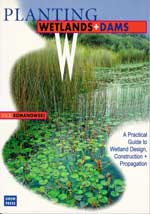 |
Planting wetlands and dams: a practical guide to wetland design, construction and propagationBy Nick Romanowski ISBN 0868406082, published in 1998 by UNSW Press, colour section, soft cover, 80 pages Price $A29.95 plus $A10 postage within Australia or $A30 overseas airmail |
Since the European settlement of Australia, enormous areas of wetlands have been drained or filled, and many of those remaining have become infested with introduced weeds and vermin. Native plants and animals have been the losers. The loss of Australia's wetlands has impoverished the landscape, reduced farm productivity, worsened flood and erosion problems, and has helped to turn water quality problems into front page news.
With increasing awareness of the value of wetlands, restoration and replanting have become urgent priorities. This unique, practical manual provides a complete, step-by-step guide to the creation of conditions in which native wetlands will thrive.
Topics covered in 'Planting wetlands and dams' include:
'Planting wetlands and dams' may be used on its own as a practical guide or as a companion volume to 'Aquatic and wetland plants: a field guide for non-tropical Australia', also published by UNSW Press.
Nick Romanowski is a wetland consultant with a background in zoology and considerable practical experience in recreating the habitat needs of aquatic animals. His nursery, Dragonfly Aquatics, was the first to specialise in Australian water and wetland plants. The nursery is also home to visiting waterbirds and a resident population of many native animals. Nick is author of the companion volume to this book 'Aquatic and wetland plants: a field guide for non-tropical Australia', and 'Water garden plants and animals: the complete guide for all Australia'. He is also author of several other books including 'Water and wetland plants for southern Australia' and 'Farming in ponds and dams: an introduction to freshwater aquaculture in Australia', and his articles on aquatic plants and animals have been widely published in journals.
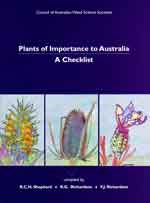 |
Plants of importance to Australia: a checklistCompiled by R.C.H. Shepherd, R.G. and F.J. Richardson ISBN 0958743959, published in 2001 by R.G. and F.J. Richardson, soft cover, section sewn, 358 pages Price $A39.95 plus $A10 postage within Australia or $A30 overseas airmail |
This book provides an accurate botanical name and a preferred common name for each plant that is or may be of importance to Australia. The plants chosen include both weeds of agriculture and the environment; crop plants including vegetables, tropical crops, orchard species and trees used for timber; ornamental species are included where they have or may become environmental weeds. The list is inclusive rather than exclusive - if a plant may become a weed, or may have value as a crop, or be a threat to our environment then we hope it has been included here.
The list follows in the tradition of A checklist of economic plants in Australia compiled by W. Hartley and published in 1979, which in turn followed the CSIRO booklet Standardized plant names published in 1942 as CSIR Bulletin No. 156 and revised as CSIRO Bulletin No. 272 in 1953. These books sought to provide standard common names for plants of economic significance in Australia. Since the last of these books was published there have been many changes to botanical names and many new species are now recognized as either weeds or valuable species in Australia.
Plants in the first section are presented in order of their botanical names by genus and species. Family names are indicated with the genus name, and the authority follows the species name. Subspecies and varieties are only included where important. Common names are provided where they exist and the first entry in the list for each species (in bold type) is the preferred common name for that species. The second section of the book is ordered by common names. Following each common name is the botanical name associated with that species. These have been arranged to indicate the preferred botanical name for that particular common name.
'The authoritative identification of any plant is its binomial botanical name. However, common names are the basis of most communication on plants throughout the community. Thus, linking common names to a botanical identification is critical for this communication. For many plants, there is more than one common name across Australia and some common names are used for more than one species. It greatly assists communication to know this range of common names for a species and to know the range of species for a common name. By providing this information, this book will be invaluable throughout the Australian community.' Bruce Wilson, President, Council of Australian Weed Science Societies
Production of this book was sponsored by Council of Australian Weed Science Societies, Cooperative Research Centre for Weed Management Systems and Victorian Department of Natural Resources and Environment.
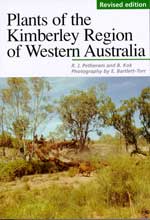 |
Plants of the Kimberley Region of Western Australia, revised editionBy R.J. Petheram and B. Kok ISBN 1920694048, published in 2003 by University of Western Australia Press, softcover, colour, 562 pages Price $A45.00 plus $A10 postage within Australia or $A30 overseas airmail |
This revised edition (original version published in 1983) includes changes to 50 plant names, and also updates the introductory sections about the Kimberley region and the principles of rangeland management. The 240 species covered in the book are organised in three sections: grasses and herbs (110), shrubs (40) and trees (90) and constitute a unique flora not dealt with in any other single text. With its straightforward text and excellent photographs this book is an important resource for pastoral managers and rangeland advisors in managing vegetation and land-use issues. It will also be a valuable reference for students of ecology and range science as well as appealing to nature-lovers, conservationists and travellers in the Kimberley region.
Dr. R. John Petheram works in research and extension in agrosystems in Australia, Africa and Asia. He coauthored this book while with the Rangeland Management Branch of the Department of Agriculture, Western Australia. He has worked for CSIRO, the Food and Agriculture Organisation, and is currently a senior lecturer in resource management at the University of Melbourne, Creswick Campus, Victoria.
Bernard Kok has been a farmer and feedlot operator in Zimbabwe, and employed as project manager for the Dunham River Scheme in the Kimberley. Later he worked as an advisor to the Rangeland Management Branch of the Department of Agriculture, Western Australia, based in Kununurra and Carnarvon. He retired in 1986 and now lives in Perth.
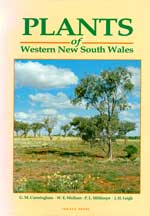 |
Plants of western New South WalesBy Geoff Cunningham, Bill Mulham, Peter Milthorpe and John Leigh ISBN 0409306878, published in 1993 by Inkata Press, colour, hard cover, 768 pages Price $A265.00 plus $A10 postage within Australia or $A30 overseas airmail |
This is a guide and reference resource illustrating and describing the great array of plants in this dry pastoral section of New South Wales. Each author became aware of the need for a comprehensive record of these plants, for both the people involved in research and advisory services, and particularly for landholders who need to manage the plants for their livelihood. The extensive collation and description of flora, together with the many coloured plates, are an amalgamation of existing knowledge and efforts and the results of extensive research undertaken in the field by the widely-qualified authors. Plant descriptions include habitat, distribution, forage and field characteristics and the risk status of endangered plants. Its comprehensive nature makes the work significant to pastoralists and people concerned with plants throughout Australia.
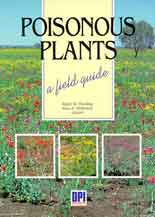 |
Poisonous plants: a field guideBy Ralph M. Dowling and Ross A. McKenzie ISBN 0724239820, published in 1993 by the Department of Primary Industries Queensland Information Series QI92035, 164 pages, colour and B&W, soft cover Price $59.00 plus $A10 postage within Australia or $A30 overseas airmail |
Describes and illustrates the major poisonous plants affecting cattle, sheep, goats, horses and pigs in Queensland and adjoining areas. Information on plant distribution and habitat is accompanied by a distribution map. In addition to the description of each plant, information is given on:
The book is an essential reference for farmers, graziers, horse owners, agricultural advisors, veterinarians, students and everyone else involved in the care of livestock.
Ralph Dowling is with the Queensland Herbarium, Department of Environment and Heritage, Queensland and Ross McKenzie the Division of Animal Health, Animal Research Institute, Department of Primary Industries, Queensland.
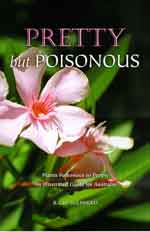 |
Pretty but poisonous
|
Pretty but Poisonous is written for home and landscape gardeners, parents, child carers, grounds maintenance staff, bush walkers and all those who enjoy the great outdoors, to help identify plants that may cause poisoning, allergies or skin reactions in people.
The book uses easy-to-understand language and colour photographs to aid plant identification. It includes hints on how to avoid plant poisoning and what to do if poisoning does occur. A simple colour coding system has been used to establish how toxic each plant is - very poisonous, poisonous, allergenic or irritant. The book also details which parts of the plant are poisonous and the toxins that are likely to be encountered, as well as symptoms of poisoning. All these plants are found in Australia.
Ros Shepherd gained her Master of Science degree from The University of Queensland in 1966 and Master of Agricultural Science degree from The University of Melbourne in 1984. She spent many years as a Senior Entomologist at the Keith Turnbull Research Institute in Frankston, Victoria working on the biological control of pest plants and animals, which included research in South Africa.
Ros has been actively involved in the Weed Society of Victoria and Council of Australian Weed Societies for many years. Her other recent publications include The Biology of Australian Weeds series and Plants of Importance to Australia: a Checklist. She is a keen gardener and bush walker and now spends much of her time travelling, in Australia and around the world, photographing plants.
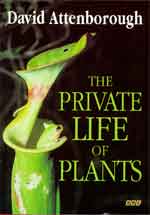 |
The private life of plantsBy David Attenborough ISBN 0563370238, published in 1995 by BBC Books, colour, hard cover, 320 pages Price $A40.00 plus $A10 postage within Australia or $A30 overseas airmail |
A fascinating view of vegetable life by one of the most successful teachers of the late 20th century.
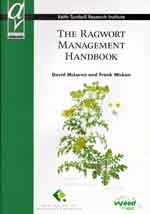 |
Ragwort management handbookBy David McLaren and Frank Mickan ISBN 0730693686, published in 1997 by DNRE Victoria, colour and b&w, soft cover, 76 pages Price $A15.00 plus $A4 postage within Australia or $A14 overseas airmail |
This practical guide to integrated control of ragwort (Senecio jacobaea) in southern Australia covers both agricultural and natural situations. It provides factual information and a range of ideas and opinions that will allow you to develop a ragwort control and rehabilitation program. The handbook describes the biology of the species and its invasive properties. It also gives guidelines for assessing the ragwort problem in particular areas, and for planning and implementing management and rehabilitation programs.
David McLaren has a Bachelor of Science with Honours and completed his Ph.D. on insect-plant interactions at La Trobe University in 1989. David spent two years working on the impact of micro-encapsulated insecticides on Honey Bees with the Department of Agriculture before he started work on biological control of weeds at the Keith Turnbull Research Institute in 1986. Ragwort has been David's main area of study, but he has also gained considerable experience in integrated weed management. David is leader of the Agricultural Eco Systems Unit at the Keith Turnbull Research Institute as well as heading the Emerging Weeds Unit there.
Frank Mickan has a diploma of Agricultural Science from the University of Melbourne, Dookie Campus. He commenced his career in 1970, assisting in dairy and beef research projects with the Department of Agriculture at the Ellinbank Research Institute and becoming the Farm Manager there in 1984. Frank became more involved in silage and sub surface drainage extension in the late 1980s. In 1992 he became the Pasture and Fodder Conservation Specialist for West Gippsland. He has wide experience in all aspects of growing pastures and their grazing management by dairy, beef, sheep, fodder conservation and all forms of soil drainage.
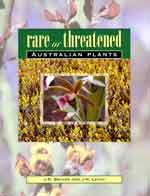 |
Rare or threatened Australian plants, 4th editionBy J.D. Briggs and J.H. Leigh ISBN 0643057986, published in 1996 by CSIRO Publishing, 6 colour maps, 4 colour photos, soft cover, 466 pages Price $A48.00 plus $A10 postage within Australia or $A30 overseas airmail |
This book is a vital reference for the national status of threatened species, particularly for rare or poorly known species, and is the most up-to-date list for conservation purposes. This edition includes a significant number of endangered and vulnerable taxa not yet considered for inclusion on either the Australian and New Zealand Environment and Conservation Council list or the Commonwealth's Schedule 1.
Now in its fourth edition, this list has expanded from 3329 taxa in 1988 to now include 5031 taxa. In addition to the overall changes in the number of taxa listed, there have been at least 3270 amendments to data for listed taxa. The list and associated coding system was developed and has been maintained by CSIRO since 1979 and lists taxa that are presumed extinct, endangered, vulnerable, rare or poorly known at the national level.
 |
Reptiles and amphibians of Australia, 6th editionBy Harold G. Cogger ISBN 1876334339, published in 2000 by New Holland, colour plates, hard cover, 808 pages OUT OF PRINT |
Winner of the Whitley Medal, this book is the definitive guide to over 1000 species of frogs, crocodiles, turtles, tortoises, lizards and snakes that comprise Australia's rich and varied herpetofauna. First published in 1975, Dr. Hal Coggar's book has become an internationally recognised and classic work in its field. With each printing the text has been expanded to take into account discoveries of new species and changes in the classification and distribution of previously known species. This sixth edition encompasses a revised master list of genera and species, the addition of 48 new species to the Appendix, new entries to the Selected References and a fully updated index.
As in previous editions, the text contains readily accessible information about distribution and habitats, as well as keys illustrated with hundreds of explanatory drawings providing quick and easy identification, distribution maps, colour photographs, a list of currently recognised species, a detailed glossary, an extensive list of references, advice on collecting methods.
Reptiles and Amphibians of Australia, with its wealth of fascinating detail, is an indispensable guide for herpetologists and those who have a broader interest in the Australian environment and its wildlife. It deserves a place on the shelves of all home libraries.
Dr. Hal Cogger graduated from the University of Sydney in 1959 and in 1963 was appointed Curator of the Department of Reptiles and Amphibians at the Australian Museum, Sydney. In 1976 he became the Museum's Deputy Director, a post he held until his retirement in 1995. He has published numerous scientific papers and reviews and has travelled extensively, especially on field work for his research on the reptiles and frogs of Australia, New Guinea and the Indo-Pacific region. A keen photographer, he believes that field studies are a vital adjunct to laboratory research. Dr. Cogger is currently the John Evans Memorial Fellow at the Australian Museum and a Conjunct Professor in the Faculty of Science and Mathematics at the University of Newcastle.
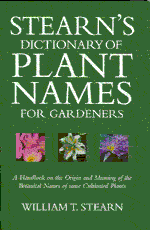 |
Stearn's dictionary of plant names for gardeners: a handbook on the origin and meaning of the botanical names of some cultivated plantsBy William T. Stearn ISBN 030436469X, this edition published in 2002 by Cassell (original publication 1972), 363 pages, hard cover Price $59.95 plus $A10 postage within Australia or $A30 overseas airmail |
In this edition Professor Stearn gives the meaning and origin of some 6000 botanical names, selecting those most likely to be encountered by gardeners and horticulturists. No other single source provides so much etymological information for the gardener, much of it out of the way, all of it enlightened by a wealth of detail, the result of years of scholarship and original research by the author. Also listed are 3000 of the most widely accepted vernacular names, cross-indexed to their correct botanical name. Both the dictionary sections are prefaced by informative and entertaining introductions. Plant classification and nomenclature are explained, and there are notes on the structure and pronunciation of botanical Latin. Extensive bibliographies direct the reader to recommended sources for further enquiry.
See 'Botanical Latin' listing
 |
Suburban and environmental weedsAn identification and information system for south-east Queensland and northern New South Wales by Sheldon Navie ISBN 1864995890, published in 2002 by CPITT University of Queensland Price $54.00 plus $5 postage within Australia or $A15 overseas airmail. CD ROM ONLY (LuciD key) |
This interactive CD-ROM provides a means for the identification of weeds commonly found in suburban areas of south east Queensland. It is also applicable to nearby areas of northern New South Wales. The CD-ROM is based on the LucID identification system which provides a user friendly way of identifying plants from characteristics that are available to the user. LucID is a filtering key that eliminates species that do not match the characteristics available. As each characteristic is selected illustrations are provided that make the selection of the correct choice easy.
Fact sheets on each weed are also included and can be accessed via botanical or common names. The sheets provide information on the origin, habitat and a description of the weed for nearly 250 species. Distinguishing features are also detailed. Good quality photographs of a variety of growth stages are also included to aid identification.
While this key is not the ideal one to take with you on a hike, it is ideal for rapid and effective identification of the sample that you bring back from your excursion. Its design means that you do not have to have specific information to make an identification. If you are missing some important characteristics you can use others and that will generally lead you to the result you want.
Correct plant identification is the key to effective plant management. This tool will go a long way to bringing plant identification within the reach of everyone. While it relates specifically to a small area of Australia it will still be of value to others. The authors are to be commended and asked to please extend this key or produce more for other areas of Australia. (Review from Plant Protection Quarterly Volume 17 Issue 3).
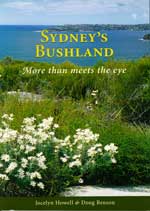 |
Sydney's bushland: more than meets the eyeBy Jocelyn Howell and Doug Benson ISBN 0731393422, published in 2000 by Royal Botanic Gardens Sydney, colour, soft cover gatefold, 128 pages Price $A27.95 plus $A10 postage within Australia or $A30 overseas airmail |
Sydney is a city of wildflowers, surrounded and infiltrated by expanses of bushland with attractive acacias, beautiful bottlebrushes and wonderful waratahs. It's also home to Geebungs, Burrawangs and Bangalays. What are these plants and where do they grow? Find out this and more as you explore the forests, woodlands and heaths of the harbour city. This book takes you back before the age of the
dinosaurs to glimpse the forces that shaped the Sydney bushland scene. And it brings you up to date to join scientists in discovering some of the surprises Sydney's bushland plants have in store:
Keen to see some of these wildflower ways for yourself? The book's last section takes you on a tour of readily accessible places where you can experience bushland landscapes and their beautiful plants. Not everything is known - there is still lots to learn. Experience Sydney's bushland in a spirit of discovery - you will enjoy finding out there's more than meets the eye!
Jocelyn Howell and Doug Benson are ecologists in the Plant Sciences Branch of the Royal Botanic Gardens Sydney. Their work has concentrated on the natural vegetation of the Sydney region, where, despite Australia's greatest concentration of people, much bushland survives. The authors have many years of experience in describing bushland areas and their significance, and produce books and maps on vegetation. They have written the well known book 'Taken for granted: the bushland of Sydney and its suburbs', and edit the scientific journal Cunninghamia: a journal of plant ecology for eastern Australia. Doug Benson is co-author of the continuing series Ecology of Sydney plant species, published in Cunninghamia. The authors apply their knowledge of Sydney's vegetation to problems of bush management, and encourage further enquiry and research.
 |
Verticordia: the turner of heartsBy Elizabeth George ISBN 1876268468, published in 2002 by University of WA Press, colour, hard cover, 432 pages Price $A95.00 plus $A10 postage within Australia or $A45 overseas airmail |
Western Australian wildflowers are internationally renowned for their beauty and variety, and verticordias are no exception. This book brings together for the first time available information on all the described taxa of Verticordia (101 species, 13 subspecies and 30 varieties) providing a comprehensive, user-friendly guide to their identification and cultivation. Species are presented in a systematic sequence that allows for easy comparison and less confusion. It is illustrated throughout with beautiful watercolours and line drawings by Margaret Pieroni, one of Australia's most talented botanical artists. Photographs of plants in their natural habitat are also included. This is the definitive guide to this exquisite and unique Australian wildflower.
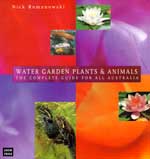 |
Water garden plants and animals: the complete guide for all AustraliaBy Nick Romanowski ISBN 0868404187, published in 2000 by University of NSW Press, colour, softcover, 112 pages Price $A39.95 plus $A10 postage within Australia or $A30 overseas airmail |
This is the first comprehensive guide to the diverse array of water and water's edge plants available in Australia. Beautifully illustrated with 190 colour photographs, more than 1000 species and varieties are described, and cultivation information is given for at least 1000 more. A chapter on water lilies covers more than 150 varieties, describing colour, fragrance, preferred climates and how reliably each type blooms.
This book also deals with that age-old problem of what to do with the wet or waterlogged spots in your garden or the seasonally wet places around your property. Other sections look at the basics of water and bog garden construction, as well as fishes and frogs, giving environmentally sound guidelines for introducing or attracting these in any part of Australia.
Nick Romanowski is a wetland consultant with a background in zoology and considerable practical experience in recreating the habitat needs of aquatic animals. His nursery, Dragonfly Aquatics, was the first to specialise in Australian water and wetland plants. The nursery is also home to visiting waterbirds and a resident population of many native animals. Nick is author of 'Planting wetlands and dams - a practical guide to wetland design, construction and propagation', and 'Aquatic and wetland plants - a field guide for non-tropical Australia'. He is also author of several other books including 'Water and wetland plants for southern Australia' and 'Farming in ponds and dams: an introduction to freshwater aquaculture in Australia', and his articles on aquatic plants and animals have been widely published in journals.
 |
Waterplants in Australia: a field guide 4th editionBy Geoff Sainty and Surrey Jacobs ISBN 0958105510, published in 2003 by Sainty and Associates, colour, hard cover, 416 pages Price $A65.00 plus $A10 postage within Australia or $A30 overseas airmail |
This expanded edition of Waterplants in Australia is essential for wetland enthusiasts. It now contains information on 150 waterplants plus chapters on charophytes, willows and stormwater management. There is also a major contribution on blue-green algae by Gary Jones and Philip Orr of the CSIRO Division of Water Resources.
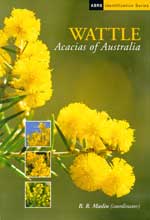 |
WATTLE: Acacias of AustraliaCoordinated by B.R. Maslin ISBN 0643066063, published in 2001 by CSIRO/ABRS Identification Series, includes manual Price $A110.00 plus $A5 postage within Australia or $A15 overseas airmail CD ROM ONLY (LudiD key) |
With the aid of WATTLE you will be able to identify any species of Acacia in Australia. This powerful electronic key enables species to be quickly and accurately named, irrespective of whether specimens are in flower or fruit. WATTLE is also a comprehensive information package, with descriptions and illustrations of the nearly 1200 species, subspecies and variants of Acacia in Australia.
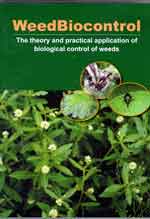 |
Weed Biocontrol - the theory and practical application of biological control of weedsBy CPITT, University of Queensland / CSIRO / DNRM Queensland ISBN 1864995882, published in 2002 by The University of Queensland, CD-ROM Price Price $50 plus $A5 postage within Australia or $A15 overseas airmail |
An interactive CD-ROM for those who want to learn more about the theory and practical application of biological control of weeds. It is a training and resource package for researchers, advisors and students, providing comprehensive information and training material for improving knowledge on all aspects concerning the biological control of weeds. A major feature of this interactive knowledge management tool is that users can navigate through the content in any way they want to meet their own specific information and learning needs. The combination of video, images and text provides a unique way of accessing the wealth of material contained on the CD. A customised search engine provides a rapid means of directing the user to specific topics. WeedBiocontrol contains sections on Frequently Asked Questions, the steps involved in weed biocontrol, a Resource Centre and various other information including References, Glossary and Links to relevant websites.
A team involving CSIRO Entomology, the Queensland Department of Natural Resouces and Mines and the Centre for Pest Information Technology and Transfer (CPITT) at the University of Queensland developed the product.
System requirements:
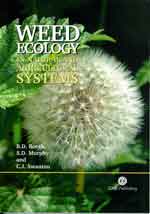 |
Weed ecology in natural and agricultural systemsBy B.D. Booth, S.D. Murphy and C.J. Swanton ISBN 0851995284, published in 2003 by CABI Publishing, 303 pages, b/w, soft cover Price $103.70 plus $A10 postage within Australia or $A30 overseas airmail |
An understanding of weed ecology is central to the processes involved in integrated weed management. In the past weeds have been ‘controlled’ and over the last fifty or so years herbicides have been what we first thought of when the term weed control is used. The pattern is changing, we now talk about weed management, realizing that the relatively simple approach of killing the weed then forgetting about it is no longer enough. To manage weeds and to integrate their management into the cultural practices of agriculture or the ecosystems of natural areas requires a good working knowledge of plant ecology.
This book has been designed as a teaching text for undergraduate students. It does not require an ecological background, only an understanding of basic biology. The material has been organized in a clear and concise manner. Each chapter begins with a list of concepts and ends with a series of questions. Common names of plants are used throughout, although the botanical name is given at the first mention in each chapter.
The authors are Canadian, from the Universities of Guelph and Waterloo. The book, however, has worldwide relevance and its illustrations and references are drawn from most of the western world. It is clearly laid out, with copious illustrations, and is fully referenced.
It is divided into five parts. Part I looks at population ecology, describing distribution and abundance of populations, population dynamics, sexual and asexual reproduction and the stages from seed to the death of the plant. Part II has three chapters looking at various aspects of population interactions. Part III studies community ecology looking at community concepts and diversity, community dynamics and plant invasions. Part IV explores the importance of weed ecology to weed management. Part V is a comprehensive glossary and subject and species indexes are provided. Chapters are also included that explore experimental design and the methodology used in ecological studies.
This is a book that will provide a link between weed biology, plant invasions and the in-depth studies of plant ecology. This book examines weeds in ecosystems that range from intensively managed agricultural systems though grazing systems to natural ecosystems. Is this an impossible task? The answer is no because all systems are controlled by essentially the same processes.
Weed control, without an understanding of ecology, can have unwanted consequences. For example, weeds can develop resistance to herbicides when they are used repeatedly on the same population, remove one weed and another will appear in its place.
This book will provide an invaluable pathway to an improved understanding of weed ecology and in turn effective weed management. It is an essential reference to all students of weed science.